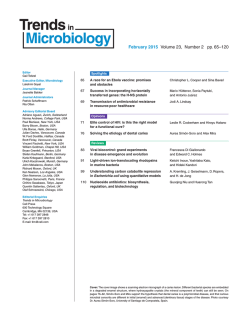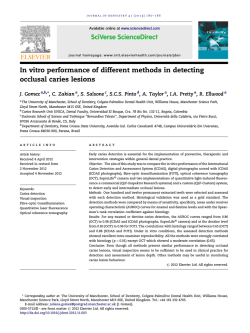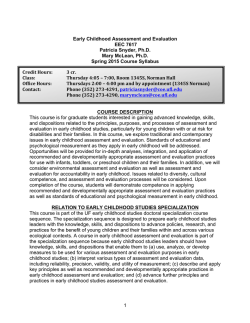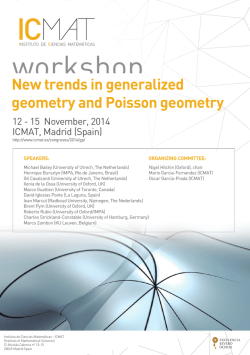
SIMPLE PREDICTIVE MODEL FOR EARLY CHILDHOOD CARIES
ARTICULO ORIGINAL SIMPLE PREDICTIVE MODEL FOR EARLY CHILDHOOD CARIES OF CHILEAN CHILDREN MODELO SENCILLO PARA PREDICCION DE CARIES TEMPRANA DE LA INFANCIA EN NIÑOS CHILENOS Brunotto M, Fierro Monti C, Perez Flores A Abstract Introduction: Early Childhood Caries (ECC), in both industrialized and developing countries, is the most prevalent chronic disease in childhood and it is still a health public problem, affecting mainly populations considered as vulnerable, despite being preventable. Objective The purpose of this study was to obtain a simple predictive model based on risk factors for improving public health strategies for ECC prevention for 3-5 year-old children. Methods - Clinical, environmental and psycho-socio-cultural data of children (n=250) aged 3-5 years, of both genders, from the Health Centers, were recorded in a Clinical History and Behavioral Survey. Results-24% of children presented behavioral problems (bizarre behavior was the main feature observed as behavioral problems). The variables associated to dmf ≥4 were: bad children temperament (OR=2.43 [1.34, 4.40]) and home stress (OR=3.14 [1.54, 6.41]). It was observed that the model for male gender has higher accuracy for ECC (AUC= 78%, p-value=0.000) than others. Conclusions- Based on the results, we proposed a model where oral hygiene, sugar intake, male gender, and difficult temperament are main factors for predicting ECC. This model could be a promising tool for cost-effective early childhood caries control. Keywords Early childhood caries; prevention; health primary care Resumen Introducción: Las caries temprana de la infancia (CTI), a pesar de ser una enfermedad prevenible, permanece como uno de los problemas de salud pública, tanto en países industrializados como en los que están en vías de desarrollo, afectando principalmente a poblaciones vulnerables. Objetivo: el objetivo de este trabajo fue generar un modelo sencillo basado en factores de riesgo que sea predictivo del riesgo de CTI en niños de 3-5 años de edad a fin de mejorar las estrategias preventivas a nivel de salud pública. Métodos: Se recolectaron datos clínicos, del hogar y psico-socio-cultural de niños (n=250) de ambos sexos que concurren a centros de salud en la región del Bio Bio –Chile mediante historia clínica y encuesta de comportamiento. Resultados: 24% de los niños presentó problemas de comportamiento (un comportamiento extraño fue la principal característica observada como problema de comportamiento). Las variables asociadas a ceo ≥4 fueron: mal temperamento del niño (OR=2,43 [1,34; 4,40]) y estrés del hogar All authors declare no potential conflicts of interest with respect to the authorship and/or publication of this article Revista de la Facultad de Ciencias Médicas 2014;71(3):105-112 105 Model for early childhood caries of chilean children (OR=3,14 [1,54; 6,41]). Se observe que el modelo estratificado por género masculino fue el que presentó la mayor precisión diagnóstica de CTI (AUC= 78%, p-valor=0.000); además Conclusiones: Proponemos un modelo donde la higiene oral, el consumo de azúcar, el género masculino y el mal temperamento son los principales factores de predictivos de CTI. Este modelo podría ser una herramienta promisoria para el costo-efectividad del control de caries temprana. Palabras claves Caries temprana de la infancia, atención primaria de la salud, prevención Introduction Early Childhood Caries (ECC), in both industrialized and developing countries, is the most prevalent chronic disease in childhood and it is still a health public problem, affecting mainly populations considered as vulnerable, despite being preventable. In the development of ECC, several factors, such as oral hygiene procedures, fluoride drinking water, infant feeding habits, dietary cariogenic habits, and psycho-social factors, are involved. 1-3 The goal in the development of dental interventions is to build theoretical and empirical models for health prevention. Authors such as Giannoni et al. 4 carried out a review of studies on prediction methods to evaluate caries risk factors in order to establish contextrelated oral health programs. Pine et al. 5 reported that critical areas to be considered in these models were social and cultural aspects surrounding child development, such as family stress, nutrition, access to fluoride and use of sugars, composition and activity of oral microflora, as well as recognition of behavioral and biological impacts on health. In addition, family stresses, difficult temperaments of the children and dysfunctional parenting behaviors may lead to a child being at risk for ECC.6 Several conceptual models have been suggested, although the clinical practice of caries risk assessment has no model that is sufficiently simple for children aged 3-5 years and applicable at health primary care services.6, 7 The purpose of this study was to obtain a simple predictive model based on risk factors for improving public health strategies for ECC 106 prevention for 3-5 year-old children. Materials and Methods Study design Children (n=250) aged 3-5 years, both genders, were recruited from the Health Centers belonging to the Municipality of Concepción included in the health insurance system, National Health Fund. Cases were children aged 5 years or less, at least had four caries; one or more affecting maxillary incisors. Children who presented systemic pathologies, mental diseases or disabilities and children without adults, and/or taking any medicines were excluded. Inclusion criteria were that children were medically healthy, had full primary dentition, and were without systemic chronic diseases. Successive children who fulfilled inclusion criteria were enrolled. The study was approved by the Research and Ethics Committee, and followed the guidelines of the Declarations of Nuremberg, Helsinki, and Tokyo of the World Medical Association. Informed consent forms were signed by the parents or guardians of all children. Cluster sampling was carried out according to the population distribution of the Health Service of Concepcion, Department of Health Information, of those attending every health center (http://www.minsal.cl). Significance level and efficiency were α=0.05 and 80%, respectively. The number of children was calculated as , where p is the a priori supposed response, c is the amplitude of the confidence interval and z represents the probability obtained from a normal distribution with expectation 0 and va- Revista de la Facultad de Ciencias Médicas 2014;71(3):105-112 ARTICULO ORIGINAL Variable Categories Cut-off criteria ECC (outcome) 0: dmf with values between 0 and 3 (controls); According to American Academy of Pediatric Dentistry 8 1: dmf with values ≥ 4 (cases) Child education 0: kindergarten Via anamnesis 1: child care Gender 0: male Via anamnesis 1: female Child behavior 0: the score < percentile 90 means without problems 1: the score > percentile 90 means with problems Mother Stress 0: the score < percentile 90 means without problems 1: the score > percentile 90 means with problems Home Environment 0: the score < percentile 90 means without problems 1: the score > percentile 90 means with problems Bottle 0: no consumption According to Survey developed by Rodriguez et al.12 According to Survey developed by Rodriguez et al.12 According to Survey developed by Rodriguez et al. 12 Via anamnesis 1: yes consumption Oral Hygiene 0: acceptable; 1: deficient and insufficient According to the simplified Greene and Vermillion index 14 Table 1.Criteria and cut-off points of study variables riance 1. The study variables and their corresponding cut-off points are shown in Table 1. Study Measures Behavioral and Socioeconomic Measures The instrument performed and validated by Rodriguez et al.9 for Chilean population was used to assess of the behavioral and socioemotional problems of children. This survey consists of three parts evaluating: a) behaviour and emotions of the children; b) perceptions and emotions of the mother, and c) socioeconomic conditions of the child’s home. A score ≥ percentile 90 means difficult temperaments of the children, home stress and mother stress. The socioeconomic level was evaluated through the GRAFFAR Index 10, an international outline for clustering children and adolescents based on the social characteristics of family, father's profession, education level, sources of income, kind of house and features of geographic area. Families are classified into five strata: Class I and II: higher level status; Class II and III: medium level; and Class IV and V: relative and critical poverty. Dental clinical exam Oral health examinations were performed by a specialist in pediatric dentists previously training with psychologist. The study involved routine instrumental exploration with artificial light after cleaning teeth with a toothbrush and drying them. The following variables were observed: oral hygiene (OH), following the simplified Greene and Vermillion index 11; and dmf (decayed-missing-filled in temporary teeth), following the WHO criteria.12 Statistical Analysis and Models The free software R 2.15.3 (www.r-project. org) was used. Data analysis was as follows, and critical level for establishing statistical significance was set at p<0.05: a) Estimated association among variables was performed by table 2x2, odd ratios (OR) and 95% confidence intervals (CI95%); and Cochran-Mantel-Haenszel test for stratification analysis; b) Logistic models were built to estimate the predictive values (only significant variables were included in the models); d) The accuracy of each model built was assessed by the Area Under the Receiver Operating Characteristic (ROC) Curve (AUC) estimated by non-parametric methods. Results Biodemographic aspects Of the total of children observed, 51.0% were male, 82% went to kindergarten and their me- Revista de la Facultad de Ciencias Médicas 2014;71(3):105-112 107 Model for early childhood caries of chilean children dian age was 4 years. Usually, the family composition was one or two children, mothers had a median age of 30 years and a high percentage (94%) had secondary or university studies, and 52% had no partner. Child dentistry aspects In relation to the dentistry clinic characteristics and habits associated with oral health, it was observed that a 47% of children used a bottle and 47% of the total had deficient oral hygiene. 53% of the children consumed sugar 4 or more times per day. In the children study population, 163 (65%) had presence of dmf< 4, and 87 (35%) had dmf ≥ 4. The variables associated to dmf ≥4 were inappropriate oral hygiene (OR=4.03[2.28, 7.12]); bottle use (OR=1.891.12, 3.19]); sugar intake≥4 times per day (OR=3.75[2.10, 6.70]) (Table 2). the main feature observed (38%) as behavioral problems. The variables associated to dmf ≥4 were: bad children temperament (OR=2.43 [1.34, 4.40]) and home stress (OR=3.14 [1.54, 6.41]). The associated variables of survey to children behavior with dmf ≥4 were aggressiveness, reticence, immaturity, diminished imagination, gender temperament, and fear (Table 3). Logistic Models It was built two models: a) model without stratification, and b) model split by gender. It was observed that the model for male gender has higher accuracy (AUC= 78%, p-value=0.000) than others. And it was observed in the model for male gender that the child behavior variable was associated with the presence of early decay (Table 4). The Figure 1 shows a final graph model built in order to explain the associations and magnitude of association (OR and 95%CI) among studied variables. Behavioural and socio-economic aspects The majority of families belonged to Class IV (56%), and Class III (42%) Graff Index (Table 1). 24% of children presented behavioral problems, and unusual/bizarre behavior was Total subjects (n=250) Variables Categories RF (AF) χ2 test dmf ≥ 4 dmf< 4 (n=87) (n=163) Female 37 (30.3) 85 (69.7) Male 50 (39.1) 78 (60.9) Schooling level- child Kindergarten 68 (78.2) Schooling level-mother Primary 6(6.9) Secondary 53 (60.9) 117 (71.8) University 28 (32.2) 38 (23.3) Appropriate 22 (25.3) 94 (57.7) Inappropriate 65 (74.7) 69 (42.3) No 60 (69.0) 83 (73.5) Yes 27 (31.0) 30 (26.5) <4 48 (55.2) 134 (82.2) Gender Oral Hygiene Bottle Use Sugar intake frequency per day Crude OR; (CI95%) p-value(*) 0.1473 1.47; (0.87, 2.48) 137 (84.0) 0.2484 0.68; (0.35, 1.30) 8 (4.9) 0.2149 -------------- 0.0000 4.03; (2.28, 7.12) 0.0175 1. 89; (1.12, 3.19) 0.0000 3. 75; (2.10, 6.70) 0.1658 ---------------- ≥4 39 (44.8) 29 (17.8) Socio Economic Status IG-II 4 (4.6) 2 (1.2) (Graff Index) IG-III 32 (36.8) 72 (44.2) IG-IV 51 (58.6) 89 (54.6) Children behavior Score ≥ percentile 90 30 (34.5) 29 (17.8) 0.0031 2.43; (1.34, 4.40) Mother stress Score ≥ percentile 90 12 (13.8) 11 (6.7) 0.0664 2.21; (0.95, 5.16) Environment stress Score ≥percentile 90 21 (24.1) 15 (9.2) 0.0014 3.14; (1.54, 6.41 Table 2.Biodemographic and Behavioral and Socioeconomic features, clinical dental exam and oral habits measured. RF: relative frequencies; AF: absolute frequencies. (*) Association statistical significance set at p≤0.05 between dmf≥4 (outcome) and other variables. 108 Revista de la Facultad de Ciencias Médicas 2014;71(3):105-112 ARTICULO ORIGINAL Respondent Survey questions Proportion p-value (dmf≥4) χ2 Child Aggressiveness 0.24 Reticence Immaturity Mother OR LB 95% UB 95% p - v a l u e OR CMH MH L B 95% UB 95% 0.0158 2.28 1.16 4.45 0.0173 2.27 1.26 4.10 0.24 0.0234 2.15 1.11 4.18 0.0334 2.08 1.17 3.70 0.41 0.0081 2.10 1.21 3.64 0.0183 1.98 1.23 3.20 Rare behavior 0.42 0.0000 3.54 2.06 6.10 0.0000 3.43 2.41 4.89 No sphincter control 0.21 0.1985 1.54 0.80 2.97 0.2750 1.45 0.84 2.47 Anxiety 0.16 0.1052 1.89 0.88 4.08 0.1329 1.83 0.94 3.53 Diminished imagination 0.17 0.0053 3.19 1.39 7.32 0.0070 3.15 1.45 6.82 Gender Behavior 0.10 0.0171 3.65 1.23 10.78 0.0116 4.07 1.39 11.88 Fear 0.31 0.0036 2.48 1.34 4.61 0.0041 2.48 1.43 4.29 Depression 0.14 0.0064 3.40 1.38 8.38 0.0049 3.48 1.48 8.16 Partner relationship 0.24 0.0014 3.14 1.54 6.41 0.0016 3.05 1.59 5.86 Abandon 0.11 0.1368 1.99 0.81 4.88 0.1338 2.00 0.91 4.39 Isolation 0.08 0.2191 1.95 0.68 5.56 0.2155 1.94 0.77 4.88 Problem 0.21 0.0005 3.86 1.77 8.44 0.0006 3.79 1.80 7.96 Table 3. Association among survey questions and dmf≥4. Significant level was fixed 5%. CMH: Cochran-Mantel-Haenszel test. MH: Mantel-Haenszel test OR: Odd ratios, CI95%:95% confidential intervals, UB: upper bound; LB: low bounder. Reference category: first. Bold letter: indicate significant association. Figure 1. Graph model for risk of early childhood caries. Arrows indicated a direction of association and the numbers correspond to Odd Ratios and its respective 95% confidence intervals. Discussion The high prevalence of ECC produces adverse health effects, as well as high rates and costs of restorative and surgical procedures. ECC is the most preventable complex disease in children younger than 5 years, but is influenced by multiple factors.13, 14 In our study, the main identified variables are risk known factors of ECC: sugar intake, oral hygiene, and bottle use. In addition mother stress, child behavior, and home stress were observed related to mentioned variables. Numerous studies have described risk factors of ECC such as social status, behavior, oral hygiene, among others. 6-7, 15-16 Severe caries in preschool children has long been considered as “nursing caries” or “bottle caries” and is attributed to prolonged bottlefeeding with sweetened liquids.17 The latest literature suggests that use of a sugar-containing liquid in a bottle may be an important, although not necessarily the only, etiological factor.18 In agreement with the majority of studies, we observed a significantly association with ECC. Furthermore, 53% of the children consumed sugar 4 or more times per day. A significant association was seen between dmf ≥ 4 and higher frequency of sugar intake (4 or more). Related to this result, studies by Palmer et al. 18 stated that sugar food frequency, among other factors, was associated with severe ECC. Prakash et al. 19 also showed that decay increased significantly when snacks were consumed between meals. Approximately 47% of children presented Revista de la Facultad de Ciencias Médicas 2014;71(3):105-112 109 Model for early childhood caries of chilean children CI 95% Stratification by Without Female Male ROC Parameter Estimated SE OR LB UB χ2 p-value Constant 1.45 0.53 4.25 1.51 11.95 7.51 0.0061 Sugar take -0.85 0.33 0.43 0.23 0.81 6.78 0.0092 Bottle use -0.11 0.31 0.90 0.49 1.64 0.13 0.7208 OH -1.07 0.31 0.34 0.19 0.63 11.75 0.0006 Children Behav -0.34 0.35 0.71 0.36 1.41 0.94 0.3330 Mother stress -0.38 0.50 0.69 0.26 1.81 0.58 0.4478 H o m e -0.48 stress 0.41 0.62 0.27 1.40 1.34 0.2475 Constant 0.62 0.75 1.87 0.43 8.15 0.69 0.4062 Bottle use -1.19 0.46 0.30 0.12 0.75 6.67 0.0098 OH -1.14 0.46 0.32 0.13 0.78 6.21 0.0127 H o m e 0.08 stress 0.72 1.08 0.26 4.41 0.01 0.9138 Mother stress -1.29 0.80 0.27 0.06 1.31 2.64 0.1044 Children Behav 0.94 0.76 2.57 0.58 11.34 1.55 0.2125 sugar take -0.02 0.52 0.98 0.35 2.72 0.001 0.9697 Constant 2.58 0.85 13.2 2.50 69.7 9.22 0.0024 Bottle use 0.88 0.49 2.40 0.93 6.24 3.25 0.0714 OH -1.16 0.48 0.31 0.12 0.81 5.76 0.0164 H o m e -1.21 stress 0.64 0.30 0.09 1.03 3.66 0.0558 Mother stress -0.33 0.72 0.72 0.18 2.92 0.22 0.6414 Chil Behav -1.03 0.47 0.36 0.14 0.90 4.78 0.0288 in- in- Area Std. Err. p-value 0.0305 0.000 0.7618 0.0291 0.000 0.7825 0.0282 0.000 0.7449 Sugar in- -1.60 0.48 0.20 0.08 0.52 10.94 0.0009 take Table 4. Logistic Regression Models, reference category: last. OR: Odd ratios, CI95%:95% confidential intervals, UB: upper bound; LB: low bounder. The critical level was set at p<0.05 for establishing statistical significance. inappropriate OH. Several studies have associated OH habits qualitatively and quantitatively with oral microbiota 17 , and quality (protein profiles) and quantity of saliva (salivary flow per minute) 20. 30% of male children were observed to have difficult temperament and dmf≥ 4. Moreover, a significant association was found between dmf ≥ 4 in males and difficult temperament and home stress. In studies on alimentary practices and children's temperament, O’Hughes et al. 21 observed that negative emotions of parents were directly related to problems in feeding their children. These 110 authors considered that temperament plays an important role in parent–child relationship, because parents may react differently to children who are more internally controlled as compared to those who are more reactive in their temperaments. Suglia et al. observed an association between soda consumption and negative behavior in 5 year old children. Those authors performed an adjusted for sociodemographic factors analysis and observed that different consumed amounts of soda was associated with a higher aggressive behavior score compared with consuming no soda.22 Authors as Zhou et al. 23 reported that relation- Revista de la Facultad de Ciencias Médicas 2014;71(3):105-112 ARTICULO ORIGINAL ship among socioeconomic, behavioral and biological factors and ECC and they consider early life factors play an important role in the development of ECC. Generally, the proposed models of ECC in literature are highly complex and not easy to apply at primary health care level.5-7 Our focus is based on identifying the main variables that can be easily monitored at primary health care; when the risk models include a few variables, it could be enabled the screening of a large number of children. Petersen considers that certain behavioral patterns or lifestyles influence outcomes via physiological processes, and they are risks over which an individual has at least some control.24 Based on the results, we proposed a model where oral hygiene, sugar intake, male gender, and difficult temperament are main factors for predicting ECC. This model could be a promising tool for cost-effective caries control and evidence-based treatment planning. References 1. Martens L, Vanobbergen J, Willems S, Aps J, De Maeseneer J. Determinants of early childhood caries in a group of inner-city children. Quintessence Int 2006; 37:527-536. 2. VanPalensteinHeldermanWH, Soe W, van’t Hof MA.Risk factors of early childhood caries in a Southeast Asian population. J Dent Res 2006; 85:85-88. 3. Weintraub JA, Ramos-Gomez F, Jue B, Shain S, Hoover CI, Featherstone JD, Gansky SA. Fluoride varnish efficacy in preventing early childhood caries. J Dent Res2006; 85:172-176. 4. Giannoni M, D'Amario M, Gatto R, Barone A.Some tools for the identification of high caries risk individuals. A review. Minerva Stomatol. 2005; 54:111-127. 5. Pine CM, Adair PM, Petersen PE, Douglass C, Burnside G, Nicoll AD, et al. Developing explanatory models of health inequalities in childhood dental caries. Community Dent Health 2004; 21(suppl 1):86–95. 6. Seow KW. Environmental, maternal, and child factors which contribute to early childhood caries: a unifying conceptual model. Int J Paediatr Dent 2012; 22:157-168. 7. Gao XL, Hsu CY, Xu Y, Hwarng HB, Loh T, Koh D. Building caries risk assessment mo- dels for children. J Dent Res 2010, 89:637643. 8. American Academy of Pediatric Dentistry; American Academy of Pediatrics; American Academy of Pediatric Dentistry Council on Clinical Affairs Policy on early childhood caries (ECC): classifications, consequences, and preventive strategies. Pediatr Dent 20052006; 27(7 Suppl):31-43. 9. Rodríguez S, Lira M, Arancibia V &Bralic S. IPCS: Inventario de problemas conductuales y socioemocionales para niños entre 3 y 5 años. Santiago de Chile. Ediciones Universidad Católica de Chile. 1996 10. Méndez-Castellano H y Méndez MC. Estratificación social y biología humana. Arch Venez Puer Ped 1986; 49:93-104. 11. Greene JC, Vermillion JP. The simplified oral hygiene index. JADA 1964; 68:7–14 12. World Health Organization. Oral health surveys: basic method. 4th version. Geneva: World Health Organization. 1997 13. Irvine JD, Holve S, Krol D, Schroth R. Early childhood caries in Indigenous communities A joint statement with the American Academy of Pediatric. Paediatr Child Health 2011; 16:351364. 14. VadiakasG.Case definition, aetiology and risk assessment of early childhood caries (ECC): a revisited review.Eur Arch Paediatr Dent. 2008; 9(3):114-25. 15. Slabsinskiene E, Milciuviene S, Narbutaite J, Vasiliauskiene I, Andruskeviciene V, Bendoraitiene EA et al. Severe early childhood caries and behavioral risk factors among 3-yearold children in Lithuania. Medicina (Kaunas) 2010; 46:135-141. 16. Caufield PW, Li Y, Bromage TG. Hypoplasia-associated Severe Early Childhood Caries – A Proposed Definition. J Dent Res 2012; 91:544-550. 17. Pereira JV, Leomil L, Rodrigues-Albuquerque F, Pereira JO, Astolfi-Filho S. Bacterial diversity in the saliva of patients with different oral hygiene indexes. Braz Dent J. 2012; 23(4):409-16. 18. Palmer CA, Kent R Jr, Loo CY, Hughes CV, Stutius E, Pradhan N et al. Diet and caries-associated bacteria in severe early childhood caries. J Dent Res 2010; 89:1224-1229. 19.Prakash P, Subramaniam P, Durgesh B.H., Konde S. Prevalence of early childhood ca- Revista de la Facultad de Ciencias Médicas 2014;71(3):105-112 111 Model for early childhood caries of chilean children ries and associated risk factors in preschool children of urban Bangalore, India: A crosssectional study. Eur J Dent 2012; 6: 141–152. 20. Mina S, Riga C, Azcurra AI, Brunotto M. Oral ecosystem alterations as non-invasive monitoring for celiac children: a follow-up study. Arch Oral Biol. 2012; 57:154-160. 21. O’ Hughes S and Shewchuk RM. Child temperament, parent emotions, and perceptions of the child's feeding Experience. Intern J Behavioral Nutr and Physical Activity 2012; 9:64. 112 22. Suglia SF, Solnick S, Hemenway D. Soft Drinks Consumption Is Associated with Behavior Problems in 5-Year-Olds.J Pediatr. 2013; 163(5):1323-8. 23. Zhou Y, Yang JY, Lo EC, Lin HC. The contribution of life course determinants to early childhood caries: a 2-year cohort study. Caries Res. 2012; 46(2):87-94. 24. Petersen PE. Sociobehavioural risk factors in dental caries – international perspectives Community Dent Oral Epidemiol. 2005;33(4):274-9. Revista de la Facultad de Ciencias Médicas 2014;71(3):105-112
© Copyright 2026



